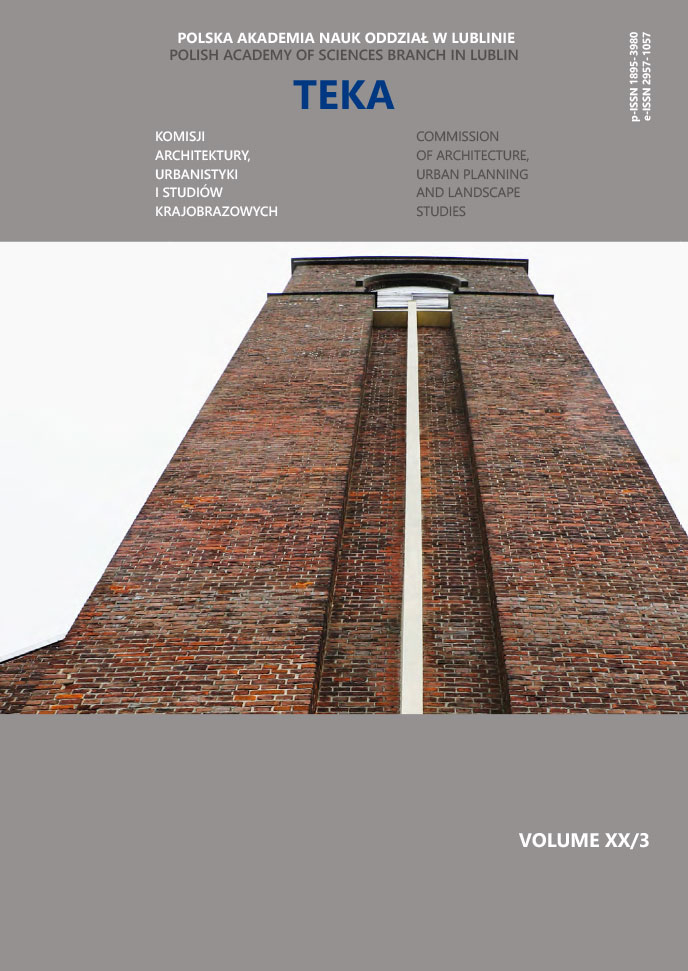Pionierska eksploracja gór wyrażona poprzez architekturę
Dariusz Kronowski
dariusz.kronowski@wp.plWydział Architektury i Sztuk Pięknych, Krakowska Akademia im. Andrzeja Frycza Modrzewskiego (Polska)
https://orcid.org/0000-0002-5510-2122
Abstrakt
Opracowanie ma za zadanie uporządkowanie wiedzy n.t. rozwoju architektury górskiej. Obejmuje okres czasowy, od powstawania pierwszych schronień, powiązany z pionierskimi odkryciami w dziedzinie architektury i krajobrazu gór. W aspekcie tematycznym podjęto zagadnienia turystyki oraz cech naukowych kształtowania obiektów górskich na wybranych przykładach. Również analizie poddano zagadnienia z dziedziny konstrukcji oraz wykorzystania materiałów rodzimych w zależności od lokalizacji, a także takich czynników jak klimat i tradycja miejsca. Podkreślono również znaczenie przyrody oraz próbę odpowiedzi, jak kształtować architekturę górską, nie ingerując w środowisko naturalne oraz wiązać ze sobą przyrodę i budowlę. Wskazano również różnice występujące w formach architektonicznych, a także zakres wpływu odmienności kulturowej i czerpania z wzorców.
Podczas analizy tematu autor studiował i zebrał materiały związane bezpośrednio i pośrednio z tematem. Zostały przeanalizowane wymienione w tekście dzieła architektury górskiej, a także ich historia i rozwój dziejowy. Przedstawiono analizę materiału na podstawie problematyki obejmującej przekrój opracowania, a także ważnych zakresów tematycznych, terytorialnych i czasowych charakteryzujących poszczególne etapy rozwoju architektury górskiej od początków istnienia zbadanych budowli górskich ukształtowanych przez kulturę zbieractwa i pasterstwa do analizy szczegółowej opracowanej na podstawie architektury górskiej XIX i XX wieku.
Najpierw było drewno, kamienie, ziemia – podstawowe budulce. Architektura górska to obiekty często wymagające, monumentalne o kształcie charakterystycznym dla formy terenu, mniej dla natury regionalnej, chociaż z niej się wywodzące, ale również obiekty tworzące naturę i charakter miejsca tzw. „genius loci”. Poszukiwanie fantazji, a także niepowtarzalnego piękna – wszystko to świadczy, że górska architektura nie jest tylko rzemiosłem o wąsko zakreślonych granicach, ale sztuką lekką, twórczą i nieskrępowaną. W dzisiejszym kształtowaniu architektury krajobrazu górskiego ważne jest oparcie na wiedzy historycznej. W kontraście świadomym bryła poddana jest porządkowi, czyli przeciwieństwu chaosu, zapanowaniu nad ładem na krawędzi w procesie projektowym. W budynkach, które charakteryzuje kontrast w stosunku do otoczenia – geometria i forma, a także struktura jest drogą do nieprzypadkowej architektury w trudnych warunkach. Architektury ukrytej w terenie, introwersyjnej, zamkniętej w świecie uwalniającym odbiorcę od panującego, na co dzień nieporządku. Jest to czysta pionierska twórczość architektów bez architektury tworzących obiekty od naśladownictwa jak np. szałasy oraz typowe schrony górskie oparte o czysty regionalizm.
W architekturze górskiej można wymienić trzy zasadnicze odmiany, różniące się pod względem twórczego podejścia:
- Architektura od naśladownictwa – mimesis – zasada twórczego naśladownictwa
- Architektura – harmoniczna, nawiązująca, ale niepowtarzająca wzorców
- Architektura w kontraście świadomym
Słowa kluczowe:
architektura górska, Tatry, Zakopane, Kuźnice, szałas góralski, miasteczkoBibliografia
Buszko Józef, Wielka historia polski tom 8 – Od niewoli do niepodległości, Oficyna Wydawnicza Fogra, Kraków 2000.
Google Scholar
Edoardo Gellner, Alte Bauernhäuser in den Dolomiten, Callwey, München 1980.
Google Scholar
Eljasz Walery, Szkice z podróży w Tatry, reprint wydania z 1874 roku, nr egz. 695, Krajowa Agencja Wydawnicza, Kraków 1990.
Google Scholar
Jagiełło Michał, Listy o stylu zakopiańskim 1892−1912 wokół Stanisława Witkiewicza, Wydawnictwo Literackie, Kraków 1979.
Google Scholar
Konieczniak Jan, Encyklopedia schronisk tatrzańskich, Oficyna Wydawnicza „Wierchy”, Kraków 2010.
Google Scholar
Kulig Marzena, Architektura tatrzańskich schronisk górskich Polskiego Towarzystwa Tatrzańskiego w dwudziestoleciu międzywojennym, Wydawnictwo Neriton, Warszawa 2003.
Google Scholar
Radwańska – Paryska Zofia, Paryski Witold Henryk, Wielka encyklopedia tatrzańska, wyd. „Wydawnictwo Górskie”, Poronin 1995.
Google Scholar
Rzymkowski Andrzej, Chowaniec Maciej, Ruralistyka – planowanie obszarów rolniczych i budownictwo wiejskie, Arkady, Warszawa 1972.
Google Scholar
Skoczek Andrzej, O niektórych parametrach architektonicznych kształtowania dachów wiszących w środowisku Podhala, maszynopis niepublikowany, Kraków 1961.
Google Scholar
Śmiałowski Rudolf, Architektura i budownictwo pasterskie w Tatrach Polskich, PWN, Kraków 1959.
Google Scholar
Szafer Tadeusz Przemysław, Tatrzańskie szałasy pasterskie, Wydawnictwo Zakład Historii Urbanistyki i Architektury PAN, Warszawa 1961.
Google Scholar
Teka Architektury Współczesnej Ziem Górskich, praca zbiorowa pod redakcją T.P. Szafera, Oficyna Wydawnicza Sezon, Kraków 1993.
Google Scholar
Tłoczek Ignacy, Polskie budownictwo drewniane, Zakład Narodowy im. Ossolińskich, Warszawa 1980.
Google Scholar
Werner Paul, Der Bergbauernhof, Callwey, München 1979.
Google Scholar
Węcławowicz Tadeusz, Jankowska-Marzec Agnieszka, Architektura wzruszeniowa Włodzimierza Gruszczyńskiego, Towarzystwo Naukowe „Societas Vistulana“, Kraków 1999.
Google Scholar
Witkiewicz Stanisław, Na przełęczy, Wydawnictwo LTW, reprint Warszawa 1891.
Google Scholar
Witruwiusz, O architekturze ksiąg dziesięć, wyd. Pruszyński i spółka, Warszawa 2004.
Google Scholar
Autorzy
Dariusz Kronowskidariusz.kronowski@wp.pl
Wydział Architektury i Sztuk Pięknych, Krakowska Akademia im. Andrzeja Frycza Modrzewskiego Polska
https://orcid.org/0000-0002-5510-2122
Adiunkt na Wydziale Architektury i Sztuk Pięknych Krakowskiej Akademii im. Andrzeja Frycza Modrzewskiego. Ukończył Wydział Architektury Politechniki Krakowskiej projektem „Ośrodka dydaktyczno-turystycznego w Gorczańskim Parku Narodowym”. Na tej samej uczelni uzyskał stopień doktora w zakresie historii i konserwacji zabytków architektury oraz urbanistyki. Napisał dysertację „Tworzenie formy architektonicznej w krajobrazie górskim – zagadnienia wybrane” pod kierunkiem prof. dr hab. inż. arch. Wojciecha Kosińskiego. Autor artykułów naukowych i publicystycznych. Aktywny architekt, członek Małopolskiej Izby Architektów. Uczestnik konkursów oraz projektów koncepcyjnych i zrealizowanych, które autor prezentował na wystawach w katalogach, m.in. Biennale Architektury 2002, Architekci Małopolski 2010, Biennale Architektury 2015, Architekci Małopolski 2017.
Statystyki
Abstract views: 183PDF downloads: 234
Licencja

Utwór dostępny jest na licencji Creative Commons Uznanie autorstwa – Na tych samych warunkach 4.0 Miedzynarodowe.




